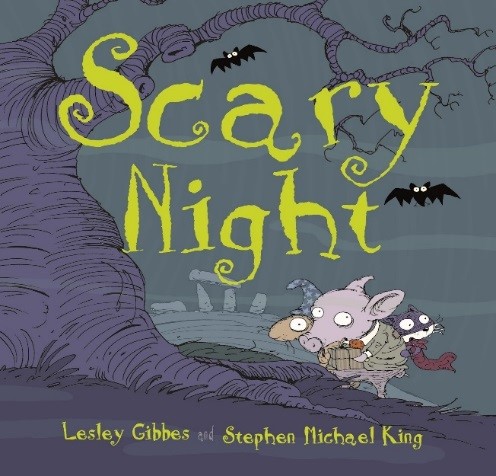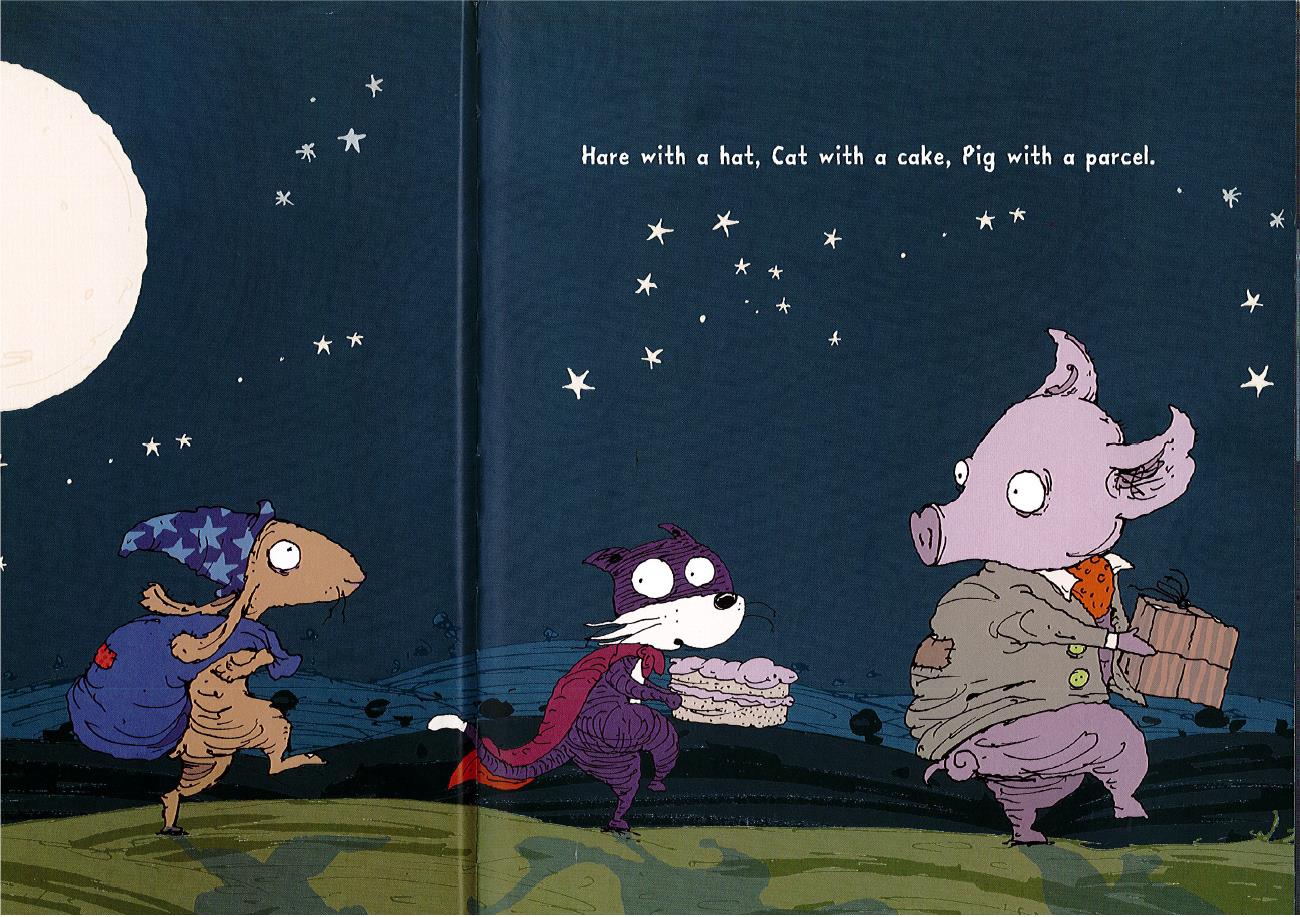This lesson assumes students have already been read the picture story book Scary Night by Lesley Gibbes and Stephen Michael King (Copyright © 2014, Adelaide SA: Working Title Press) for enjoyment and understanding.
Text
 Scary Night by Lesley Gibbes and Stephen Michael King
Scary Night by Lesley Gibbes and Stephen Michael King
Copyright © 2014, Adelaide SA: Working Title Press
Overview
In this phonological awareness activity, the goal is for students to hear the initial sound (phoneme) in the words contained in the line of text on pages 3 and 4: "Hare with a
hat,
Cat with a
cake and
Pig with a
parcel". As the sound is identified, students will be encouraged to orally generate other words that start with the same sound.
Once the sound has been established and students can orally generate new words that start with the same sound, they will be encouraged to match the identified phoneme to a grapheme and write it.
Links to the Victorian Curriculum – English
Speaking and Listening, Language: Phonics and word knowledge
Foundation:
Reading and Viewing, Language: Phonics and word knowledge
Foundation:
Writing, Literacy: Creating Texts
- Understand that sounds in English are represented by upper- and lower-case letters that can be written using learned letter formation patterns for each case (Content description VCELY162)
Links to the Victorian Curriculum – English as an Additional Language (EAL)
Pathway A
Speaking and listening
Level A1:
- Imitate pronunciation, stress and intonation patterns
(VCEALL027)
- Respond simply to questions and prompts
(VCEALC002)
Level A2:
- Repeat or modify a sentence or phrase, modelling rhythm, intonation and pronunciation on the speech of others
(VCEALL109)
- Respond appropriately in a range of common social and classroom situations
(VCEALC084)
Reading and viewing
Level A1:
Level A2:
Writing
Level A1:
- Contribute ideas, words or sentences to a class or group shared story
(VCEALA062)
- Use appropriate letter size, spacing and letter formation
(VCEALL078)
- Choose a topic to write or draw about
(VCEALA061)
- Handwrite, draw or choose materials with particular care when writing for special purposes
(VCEALA064)
Level A2:
- Contribute to shared writing activities
(VCEALA142)
- Write legibly
(VCEALL157)
- Demonstrate understanding that handwritten texts usually need to be planned, edited and presented
(VCEALA143)
- Use a range of writing implements and writing styles for different purposes
(VCEALA144)
Pathway B
Reading and viewing
Level BL:
Level B1:
- Participate in simple group activities on shared texts, with some support
(VCEALC270)
- Identify common syllables and patterns within words
(VCEALL288)
Writing
Level BL:
- Express imaginative or personal ideas in simple forms of writing
(VCEALC218)
- Contribute ideas to shared writing activities
(VCEALA221)
- Spell a number of high-frequency words accurately
(VCEALL237)
Level B1:
- Write simple imaginative or personal texts modelled on familiar forms and repetitive patterns
(VCEALC298)
- Contribute to shared simple brainstorming of ideas and identify relevant vocabulary to be incorporated into the written work
(VCEALA301)
- Spell accurately common words encountered in the classroom
(VCEALL318)
Learning intention
- We are learning to listen for initial sounds in words and say other words that start with the same sound.
- We are learning to match a sound to a letter.
Success criteria
- I can listen for the sound at the start of a word and identify it.
- I can say another word that starts with the same sound.
- I can write the letter that makes the sound I hear.
Lesson sequence
- Reorient students to the text Scary Night by Lesley Gibbes and Stephen Michael King (Copyright © 2014, Adelaide SA: Working Title Press) and ask students to recall the storyline.
-
 Ask them to close their eyes and turn their listening ears on so that they can hear the names of the animals going to the party. Read the text on page 3 and 4, "Hare with a
hat,
Cat with a
cake and
Pig with a
parcel".
Ask them to close their eyes and turn their listening ears on so that they can hear the names of the animals going to the party. Read the text on page 3 and 4, "Hare with a
hat,
Cat with a
cake and
Pig with a
parcel". - Ask students to name the animals. What sound does each of the animals start with? (e.g. Hare-/h/, Cat-/c/, Pig-/p/).
- Repeat process with the objects they take to the party (e.g. hat-/h/, cake-/c/, parcel-/p/). What do the students notice about the beginning of those words? Introduce the metalanguage 'alliteration' and explain it means the repetition of the same or similar consonant sounds in words that are close to one another (see alliteration in the
toolkit glossary). Identify the key phonemes /h/, /c/ and /p/.
- Students turn and talk to a partner. Can they say any other words that start with the same sound as hare and hat, cat and cake, pig and parcel? (Focus is on the /c/ sound. Accept responses which begin with the /c/ sound but that might be spelt with a 'k', such as kite, king.)
- Share with the whole group.
- Model an oral innovation on the text. "I am going to change the objects that the animals take to the party but they will still start with the same sound as each animal"
(e.g. Hare with a harp, Cat with a cape and Pig with a parachute). - As a whole group orally construct a new innovation on the text.
- Use an enlarged version of page 3 and 4 so that students can see the text (or write on whiteboard/large sheet of paper) Read the text to students and ask them to identify the letters at the beginning of the animal names and objects.
- Reinforce the graphemes p, h and c (upper and lowercase). Students practise writing the letters p, h and c on whiteboards. Revise correct formation and starting points for each letter.
- Return to the success criteria to check for learning. Rove group as students turn and talk to a different partner to say what sounds they heard at the beginning of the animal names. Ask them to say another word that starts with the same sound. Check whiteboards to see the graphemes written. Match sounds to letters. Scaffold as necessary.
Going further
- Students write their innovations on the text independently or in small scaffolded groups.
- Use the same text pattern but change the initial phonemes by suggesting different animals and their alliterative objects (for example duck with a drum, fox with a fabulous fan and lizard with a lovely lollipop). Write on sentence strips, illustrate and display.
Differentiated practice
Some students will require more support to hear the sounds in words and identify the sounds that are the same. These students will need more exposure to alliteration in texts and in classroom activities. This includes incidental opportunities during the day to reinforce phonological skills, such as alliteration. For example, when eating lunch talk about the food such as tasty tomato, delicious drink and crumbly cake.
For the students who have strong knowledge of grapheme-phoneme correspondence and can recognise and generate alliteration, helping them to build noun groups by adding adjectives will further their understandings. For example, hilarious hare with a hat; cranky cat with a cake, perfect pig with a parachute. These students can evaluate the use of alliteration in books. This includes looking at the title of books and discussing why an author may have made the choice to use alliteration.
ABC Education Literacy Mini Lessons
The Department collaborated with ABC Education to create a series of videos. All 16 mini lessons based on content from the Literacy Teaching Toolkit are available on the ABC Education literacy mini lessons page.